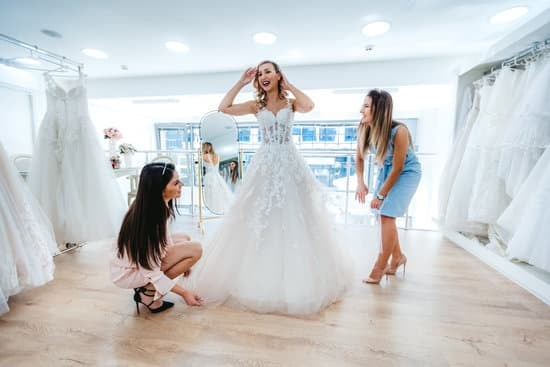The significance of wedding cakes in modern weddings cannot be overstated. It serves as a focal point of the reception, symbolizing the sweet beginning of the newlywed’s life together. One important question many couples ask is: how many guests eat wedding cake? Understanding this can help in determining the appropriate size of the cake, flavors to choose, and even accommodating dietary restrictions.
The tradition of serving a special cake at weddings dates back to ancient Rome, where a wheat or barley cake was broken over the bride’s head as a symbol of fertility and good fortune. Over time, wedding cakes have evolved in design and flavor, reflecting changing cultural customs and tastes. From traditional tiered cakes to contemporary naked cakes and cupcakes, the options are endless.
In today’s multicultural society, there are also diverse cultural influences on wedding cake traditions and guest participation. Factors such as cultural background, religious beliefs, and regional customs can all impact how many guests partake in enjoying the wedding cake. In this article, we will explore these factors and provide tips for couples to consider when planning their dream wedding cake.
The History of Wedding Cakes
As time passed and different cultures adopted this custom, wedding cakes began to take on new meanings and designs. In medieval England, couples would stack sweet buns as high as possible, and if the bride and groom were able to kiss over the tower without it toppling, they were said to have a prosperous life together. It wasn’t until the 17th century that multi-tiered fruitcakes became popular in weddings, with each layer representing prosperity for the newlyweds.
Today, wedding cakes are an essential part of any modern wedding celebration. They come in a variety of flavors and designs that reflect the tastes and personalities of the couple. From traditional white tiered cakes to more unconventional options like cupcakes or even donut towers, there are countless possibilities for couples to choose from when it comes to their wedding cake.
- The significance of wedding cakes in modern weddings
- Factors that influence how many guests eat wedding cake
- Cultural differences in wedding cake traditions and guest participation
The Evolution of Wedding Cake Designs and Flavors
The wedding cake has been a symbol of love and celebration for centuries, and over time, it has undergone significant changes in its designs and flavors. From simple fruit cakes to elaborate multi-tiered confections, the evolution of wedding cakes reflects the changing tastes and preferences of couples as well as advancements in baking techniques and ingredients.
In ancient times, wedding cakes were often made of wheat or barley, symbolizing fertility and prosperity for the newlyweds. As society progressed, sugar became more accessible and affordable, leading to the inclusion of sweeteners in wedding cakes. Over time, intricate designs such as flowers, ribbons, and figurines became popular decorations for these confections.
Today, couples have an endless array of options when it comes to choosing the design and flavor of their wedding cake. Traditional white fondant cakes are still popular, but modern couples are also opting for unique designs that reflect their personalities and interests.
From hand-painted motifs to geometric patterns, there is no limit to the creativity that can be expressed through a wedding cake. When it comes to flavors, classic choices like vanilla and chocolate are still loved by many, but adventurous flavors such as salted caramel, red velvet, and even funfetti have become increasingly popular.
According to a survey conducted by The Knot in 2019, vanilla remains the most popular cake flavor chosen by couples (26%), followed closely by chocolate (24%), and almond (15%). This data reflects not only the evolving tastes of couples but also how important it is to consider the preferences of guests when deciding on the design and flavors of the wedding cake.
After all, no matter how beautiful or delicious a wedding cake may be, ultimately its success is measured by how many guests eat wedding cake
| Cake Flavor | Percentage Chosen by Couples |
|---|---|
| Vanilla | 26% |
| Chocolate | 24% |
| Almond | 15% |
Factors That Influence the Number of Guests Who Eat Wedding Cake
There are several factors that can influence how many guests eat wedding cake at a ceremony. One of the most significant factors is the size of the wedding itself. Larger weddings with more guests are likely to have a higher percentage of people who will eat the cake compared to smaller, more intimate gatherings.
Another factor that can influence the number of guests who partake in wedding cake is the time at which it is served. If the cake is served late in the evening, after many guests may have already left, then fewer people may end up eating it. On the other hand, if it is served earlier in the reception when most guests are still present, then more people are likely to enjoy a slice.
Additionally, dietary restrictions and preferences among guests can also impact how many individuals will eat wedding cake. With an increasing number of people having dietary restrictions or following specific diets, couples often opt for alternative dessert options such as gluten-free or vegan cakes to accommodate their guests’ needs.
In order to better understand this dynamic and plan accordingly, it can be helpful for couples to communicate with their wedding caterer or baker about estimating how many guests will partake in the cake-eating tradition. This information can guide decisions about portion sizes and flavors, ensuring that there is enough cake for those who wish to partake while minimizing waste.
| Factors | Impact |
|---|---|
| Wedding size | Larger weddings may have a higher percentage of guests eating cake |
| Time of serving | Serving cake earlier in the reception may result in more participants |
| Dietary restrictions/preferences | Inclusion of alternative options like gluten-free or vegan cakes to accommodate specific diets |
Cultural Differences in Wedding Cake Traditions and Guest Participation
Throughout different cultures and traditions, wedding cakes hold a significant place in wedding ceremonies. However, the way they are incorporated into the celebration can vary greatly. From the size and style of the cake to how many guests actually partake in eating it, cultural differences play a major role in shaping wedding cake traditions.
Traditional Wedding Cake Customs
In many Western cultures, the cutting of the wedding cake is a time-honored tradition that symbolizes unity and the couple’s first task together as spouses. Guests often expect to witness this ritual and then enjoy a slice of cake themselves. In contrast, some Eastern cultures may not have a tradition of serving cake at weddings at all, or may offer alternative desserts instead.
Guesstimate: Predicting Guest Participation
Before deciding on the size and style of their wedding cake, couples need to consider how many guests will actually eat it. This can depend on cultural expectations as well as practical limitations such as dietary restrictions. In some cultures, it may be expected that every guest enjoys a piece of cake while in others only close family members or certain VIPs participate in this tradition.
Across various cultures, there are also customs around who gets to take home leftover slices of cake. Understanding these traditions can help couples plan accordingly for their big day. Ultimately, cultural differences play an important role in determining how wedding cakes are incorporated into celebrations and how many guests partake in enjoying them.
Tips for Determining the Right Size of Wedding Cake for Your Guest Count
When it comes to planning a wedding, one of the most crucial decisions that couples have to make is choosing the right size of the wedding cake for their guest count. It’s important to ensure that there is enough cake for all the guests to enjoy without ending up with an excessive amount of leftovers. Here are some tips to help you determine the right size of wedding cake for your guest count:
- Start by finalizing your guest list: Before you can determine the size of your wedding cake, you need to have a clear idea of how many guests will be attending the wedding. Make sure to account for plus ones and any additional guests that may be added later on.
- Consider the serving size: Traditionally, a standard serving size for wedding cake is around 1″ x 2″ x 4″. However, if you prefer larger servings or smaller bite-sized portions, this will impact how many people the cake can serve.
- Factor in any additional desserts: If you plan on having other dessert options at your wedding, such as a dessert bar or individual sweets, you may not need as large of a wedding cake. Take into account the variety and quantity of other desserts when determining the size of your cake.
By taking these tips into consideration and working closely with your baker or cake designer, you can ensure that your wedding cake is appropriately sized to accommodate all of your guests and their sweet tooth cravings on your special day. Ultimately, the goal is to have just enough cake so that everyone gets a slice without going overboard with leftovers.
Creative Ways to Accommodate Different Dietary Restrictions in Wedding Cakes
When it comes to planning a wedding, one of the challenges that many couples face is how to accommodate the dietary restrictions of their guests, especially when it comes to the traditional wedding cake. With an increasing number of people following different diets or having food allergies, it’s important for couples to consider these factors when deciding on the design and flavor of their wedding cake.
Customizing Flavors and Ingredients
One creative way to accommodate different dietary restrictions in wedding cakes is by customizing the flavors and ingredients. For example, if you have guests who are vegan, gluten-free, or have nut allergies, you can work with your baker to create alternative options that cater to their needs. This may include using non-dairy milk and egg replacements, gluten-free flour, or omitting nuts from the recipe altogether.
Offering Dessert Alternatives
Another approach is to provide dessert alternatives alongside the wedding cake. This could be a separate dessert table featuring a variety of sweets that cater to different dietary preferences such as fruit platters, sorbets, or even a make-your-own-sundae bar. By offering a range of options, you can ensure that all of your guests feel included and catered for.
Communicating With Guests
Finally, a proactive way to accommodate different dietary restrictions is by communicating with your guests beforehand. When sending out your invitations or RSVP cards, include a section where guests can indicate any special dietary requirements they may have. This will allow you to plan accordingly and ensure that there are suitable options available for everyone on your big day.
By considering these creative ways to accommodate different dietary restrictions in wedding cakes, you can ensure that all of your guests can partake in this beloved tradition without feeling left out due to their unique dietary needs or preferences.
The Psychology Behind Why Guests May or May Not Partake in Wedding Cake
Wedding cakes have been an integral part of weddings for centuries, symbolizing love, unity, and celebration. However, not all wedding guests choose to partake in this sweet tradition. The psychology behind why some guests may opt out of enjoying wedding cake can be influenced by various factors.
One factor that may influence whether guests choose to eat wedding cake is their personal preferences and dietary restrictions. Some guests may simply prefer not to indulge in sweets or may have dietary restrictions that prevent them from enjoying the cake. In such cases, it is important for couples to consider alternative dessert options to cater to all their guests’ needs.
Furthermore, some guests may choose not to eat wedding cake due to social or cultural reasons. For example, in certain cultures or traditions, there may be specific etiquette or superstitions associated with wedding cakes that impact whether guests feel comfortable partaking in this tradition. Understanding these cultural differences and being respectful of diverse customs can contribute to a more inclusive and enjoyable wedding experience for all guests.
Additionally, the overall atmosphere and presentation of the wedding cake can also play a role in whether guests are inclined to partake in it. A visually appealing and well-presented cake may entice more guests to indulge, whereas a lackluster presentation may deter some from participating in this traditional aspect of the celebration. Couples should consider how the aesthetic appeal and placement of the cake can influence how many guests choose to enjoy it during the reception.
Conclusion
In conclusion, wedding cakes continue to hold a significant place in modern weddings as a symbol of love and celebration. From their ancient traditions to their modern customs, the history and evolution of wedding cakes have captured the hearts and taste buds of guests for generations. The factors that influence how many guests eat wedding cake vary, including cultural differences in traditions and guest participation, as well as individual dietary restrictions.
Despite the various factors that may impact how many guests eat wedding cake, it is undeniable that wedding cakes remain a cherished part of the celebration. They are not only a delicious treat but also a reflection of the couple’s love and commitment to each other. Determining the right size of wedding cake for your guest count and finding creative ways to accommodate different dietary restrictions are important considerations when planning this important aspect of your special day.
Ultimately, the enduring appeal of wedding cakes lies in their ability to bring people together in joyous celebration. Whether large or small, traditional or modern, wedding cakes serve as a symbol of love and unity that transcends cultural differences and individual preferences. So whether all guests partake in the cake or only a few do, the presence of a beautifully designed confection at a wedding will always be an important tradition to mark this special occasion.
Frequently Asked Questions
What Percentage of Wedding Guests Will Eat Cake?
The percentage of wedding guests who will eat cake can vary depending on a variety of factors such as dietary restrictions, personal preferences, and the availability of other dessert options. However, it’s safe to say that a majority of guests do indulge in wedding cake.
Do Most People Eat the Wedding Cake?
Yes, most people do eat the wedding cake. It’s a traditional part of the celebration and often served as a dessert option after dinner. Even those who may not typically have a sweet tooth often find themselves enjoying a slice of wedding cake.
How Big of a Wedding Cake for 100 Guests?
The size of the wedding cake for 100 guests can depend on several factors such as whether the cake is the only dessert or if there are other options available. Typically, a three-tiered cake with 6, 8, and 10-inch tiers can serve around 100 guests.
However, it’s always best to consult with a professional baker for personalized recommendations based on your specific needs and desires for the wedding cake.

I have been involved in marriages for over 20 years helping couples and singles understand more about them.





